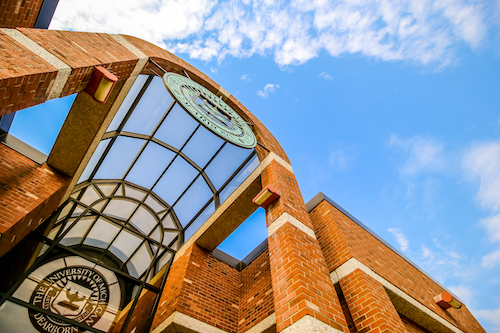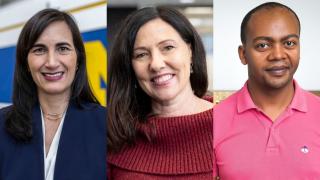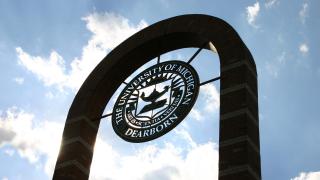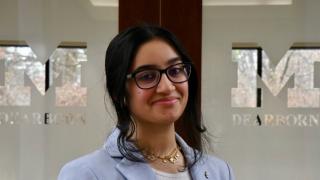
Any way you look at it, it's been a stunning couple of months for UM-Dearborn researchers. In terms of sheer grant dollars awarded, the total now stands at more than $4 million for the first two months of this fiscal year. For some context, that’s already more than half of last fiscal year's grand total. Moreover, none of the big awards so far have come from industry, typically the largest funder of UM-Dearborn research. Instead, the dollars are coming from federal funders, primarily the National Science Foundation.
“The federal grants our faculty are getting are extremely competitive; the likelihood of getting an NSF grant in some of the programs that our faculty are competing for is often less than 10 percent,” says Vice Provost for Research Armen Zakarian. “So to be getting this many in two months is an all-time record for us — by far.”
So what’s behind the recent surge of success? Zakarian says, in his view, the overarching factor is faculty research talent — something UM-Dearborn has prioritized in its recent recruitment efforts. But as you can see in the list of grants below, one of the things that Zakarian finds very promising is the slew of recent awards actually stretches through the faculty ranks, from established veterans down through early-career assistant professors.
Federal awards, July-August 2022
- Joan Remski (PI), Daniel Lawson and Marilee Benore (Co-PIs), “Retaining Students in STEM on a Commuter Campus with Efficient High Impact Practices,” National Science Foundation, $1,439,824
- DeLean Tolbert, “CAREER: No Trees Without Roots: An Investigation of Black Families Engaging in Engineering, Innovation, and Design in Informal Spaces,” National Science Foundation, $721,479
- Marouane Kessentini (PI) and Birhanu Eshete (Co-PI), “Elements: An Infrastructure for Software Quality and Security Issues Detection and Correction,” National Science Foundation, $599,999
- Sven Morgan, “Collaborative Research: The role of Grain Boundary Migration in Water Weakening of Naturally Deformed Quartz,” National Science Foundation, $433,254
- Marouane Kessentini, “PFI-TT: Intelligent Software Refactoring Bot for Continuous Integration,” National Science Foundation, $250,000
- Zheng Song, “CRII: CNS: With Uncertainty Comes Opportunity: Providing Best-Effort Edge Services with Uncertain and Limited Resources,” National Science Foundation, $174,443
- Lei Chen, “Collaborative Research: Engineering Gradient Nano-grained Metals by Multi-pass Plastic Wave Deformation,” National Science Foundation, $154,992
- Marouane Kessentini (PI) and Wencong Su (Co-PI), "IUCRC Planning Grant University of Michigan Dearborn: Center for Pervasive Personalized Intelligence Center," National Science Foundation, $20,000
Another promising trendline: There’s strong representation from various colleges. Zakarian says the haul from the College of Arts, Sciences, and Letters is particularly impressive, with about half of the entire dollar volume coming from CASL faculty.
As exciting as the past two months have been, Zakarian says the bigger payoff could be a future one. NSF awards tend to beget more NSF awards, and the fact that so many of our faculty are breaking through means we’re building a foundation for sustained success. Zakarian says their mentorship will also be invaluable for colleagues seeking the same milestone funding opportunities — and for attracting the next generation of talented researchers. “People who are thinking about coming here and want to be successful in research, they’re going to look and see what the university is successful at,” Zakarian. “So if they see their colleagues who were hired before them able to build a successful career on the national stage, that’s huge in terms of attracting even more talent.”
To keep the momentum going, Zakarian says the Office of Research is also increasing its support for faculty. Growing the research enterprise is a big part of UM-Dearborn’s strategic planning effort, and the office plans to augment the services it already offers for writing and copyediting proposals with grant administration support. This will allow faculty to stay focused on their work rather than paperwork. Another thing that’s gaining a foothold on campus: interdisciplinary faculty research groups. That could be a particularly crucial culture shift, since larger national grants typically require teams of researchers from different disciplines. On that front, Zakarian says he has his eye on several areas, including additive manufacturing technologies, sustainability, mobility and educational research. “I think if you look at areas like this, we have the right talent across all four units to be national leaders.”
###
Interested in reading more about Zakarian’s work in the Office of Research? Check out our recent interview with him, where he talks about why interdisciplinary research is becoming the norm in higher education.




